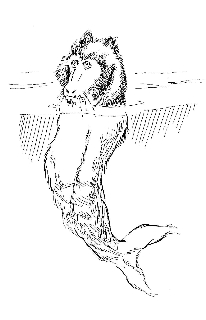Bering's 1933 expedition involved thousands of men. Among them were many scientists, brought along to document the wildlife and geology of northern Russia. One of them, Georg Wilhelm Steller, would become quite famous in his own right. Steller was a naturalist, who traveled with the expedition all the way to Alaska. Indeed, he was the first to document many Alaskan animal species-- including Steller's Eider, Steller's Eagle, Steller's Jay and the now-extinct Steller's Sea Cow.
But Steller also described one less-ordinary animal-- a creature which remains a cryptid two centuries later. He called it a "sea ape," though it has little in common with any primate. Instead, the animal was more doglike in appearance-- with tall, pointed ears and drooping whiskers. It was furry, intelligent, and playful-- much like an otter or seal. But it had no limbs, and a tail like a shark.
Steller's Sea Ape is quite a cryptozoological puzzle. It was reported by the most reliable of witnesses-- a trained zoologist, who discovered many other animal species. Steller was known to be extremely factual and accurate in his observations, so it's unlikely that he would attempt to hoax the public. But what did Steller see? Most believe that the Sea Ape was a misidentified seal. But this, to me, does not sound probable. Steller encountered many seals during his journey, and was extremely familiar with the animals. An amateur might mistake one for a Sea Ape-- but an explorer and naturalist would not.
No, it seems to me that there are two possibilities when it comes to the Sea Ape: either Steller saw something in the Alaskan seas, or he made something up. At first I thought the latter option unlikely, but recently I've changed my mind. As I said, Steller was a talented naturalist, who I highly doubt would hoax the public. But his descriptions of the Sea Ape were not publicly released. They do not appear in his official expedition reports, or in the ship's log. They can't even be found in Steller's book about the aquatic wildlife of Alaska. Clearly, Steller himself knew that the Sea Ape wasn't reputable enough to publicize. So why would he write about this creature in his journal?
Biologist Andrew Thaler has a theory that I personally quite like. He points out that, during the time when Steller described the Sea Ape, the naturalist was on poor terms with Vitus Bering. The two men had never gotten along, and tensions were especially high during the Alaskan part of the trip. Bering, like many of the crew, was extremely sick with a disease called Scurvy. Steller had recommended a simple cure, but the crew completely ignored him. With the captain sick, Steller was never allowed off the ship to explore-- something that limited his work and left him highly frustrated.
Thaler suggests that this frustration manifested itself as the Sea Ape-- meant to be an insulting caricature of Vitus Bering himself. Bering's most notable features were his moustache and pointy ears, similar to those "seen" on the Sea Ape. But this alone is circumstantial. To me, the incriminating evidence is this: Steller originally named his animal the "Danish Sea Ape." At the time, the expedition was nowhere near Denmark, and there was only one Dane on the ship: Bering.
Bering would die of scurvy during the expedition, and Steller would perish shortly thereafter. Steller thus had no way to explain that his "Sea Ape" was a joke-- it was taken to be a description of a real animal. The mistake has persisted for centuries, and Steller's Sea Ape is still listed in many cryptozoology books. In fact, it is an eighteenth-century insult, still echoing in the present day.
Read more about Steller's Sea Ape:
http://www.cryptomundo.com/cryptozoo-news/stellers-seaape/
http://www.southernfriedscience.com/?p=6968
http://www.southernfriedscience.com/?p=11327
http://www.popularsocialscience.com/2013/07/02/profiles-in-natural-history-georg-wilhelm-steller-and-the-ape-in-the-sea/
Image from http://www.cryptomundo.com/wp-content/uploads/stellers.jpg

No comments:
Post a Comment